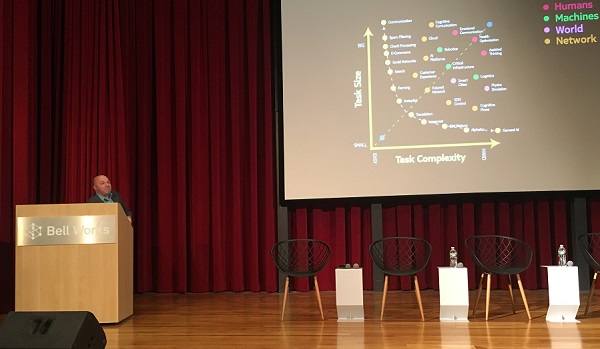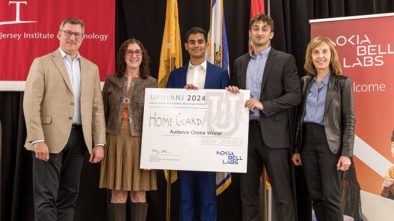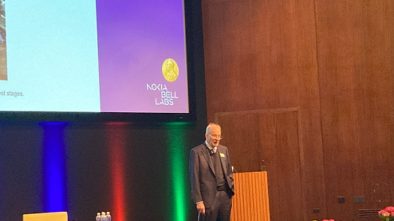Augmented Intelligence Will Optimize Every Aspect of Our Lives, Bell Labs Scientist Says at Future Forum
According to Chris A. White, of Nokia Bell Labs (Murray Hill), we’re talking about the wrong thing when we refer to artificial intelligence (AI). What we should be talking about is augmented intelligence.
“The work my team does is really the invisible AI, and it’s going to impact our lives beyond the visible AI found in products like Siri, or beyond the companies that try to use our data to sell us things. [Invisible AI] is the thing that is going to optimize every aspect of our lives.”
White, who heads Bell Labs Algorithms, Analytics, Augmented Intelligence & Devices (AAAID) Lab at Nokia, spoke at the New Jersey Tech Council Future Forum at Bell Works May 7.
He told the audience that invisible AI is about more than self-driving cars and street lights that change to prevent a pedestrian from walking out in front of a car. “It’s constant optimization of every aspect of our lives, and it’s going to be happening in the background, with only the outcomes as visible results.” Consumers will have the expectation that things are going to happen in an intelligent fashion.
The transition is happening right now, he said. We are evolving beyond artificial intelligence to augmented intelligence and a general understanding that all things will respond to our needs, understand context and save us time.
“When searching for problems that AI can address, we always look at the resources required to perform a task defined by how many times you do it, multiplied by how hard or complex it is to complete.” Chris White, Bell Labs
AI’s forte lies in two areas, he said, scaling mundane tasks and augmenting complex ones at scale. “The only reason to use AI is to actually do something at scale that you couldn’t do without that kind of automation,” he said. When typically applied, AI is used to automate the mundane, menial tasks that don’t require our full attention.
However, AI can also scale complex functions. For example, a brain surgeon only does about 200 surgeries a year, but they are extremely complex, and a surgeon needs all the relevant information he or she can get to make sure the surgery goes well. “When searching for problems that AI can address, we always look at the resources required to perform a task defined by how many times you do it, multiplied by how hard or complex it is to complete.”
Nokia Bell Labs is using augmented intelligence in the development of 5G networks, he said. These networks will give people the ability to do things they couldn’t do before because “now we have well-defined connectivity, well-defined latency and well-defined [quality of service] QoS.”
A little-known secret about these networks is that, “without intelligent automation, they are actually so complicated that they are not cost-effective or reliable.” Bell Labs is working on the augmented intelligence systems and algorithms that “make 5G both cost-effective and reliable”
Humans are better than AI in extracting what is relevant from data and associating meaning with it. Humans are also able to take something that has happened in the past that has some long-term significance to us, and combine it with current data to predict what might happen next, “which is the whole reason for doing it.”
Bell Labs thinks of the AI journey in four phases: perceiving the data, interpreting or associating it with something, using it to predict something, and then “reacting in a way that lets you take actions that are actually driven by what you are seeing.”
“We should be ashamed of ourselves that the best thinking tool we can come up with is to write down things. It is really surprising that this is where we are, with respect to what we’ve done to address all the other human limitations.” Chris White, Bell Labs
During his talk, White had a few things to say about big data. He noted that it’s only valuable when the most relevant data can be extracted and used. “The whole idea of this path through perceiving, interpreting and associating data is to be able to extract that small data and use it to optimize your situation or your existence,” he said, adding that we still don’t have the ability to digest data at scale.
“Whenever we’ve been limited on the physical side of existence, humans have built tools,” said White. For example, the wheel was invented to carry things over longer distances, the printing press to transmit information over time and space and the telescope to see farther. “We should be ashamed of ourselves that the best thinking tool we can come up with is to write down things. It is really surprising that this is where we are, with respect to what we’ve done to address all the other human limitations.”
Bell Labs has built a more advanced thinking tool that combines the ideas of augmented intelligence and associative interactive connections. “The idea that we can build something that will answer all your questions is silly,” said White. “The hardest part [about thinking] is often figuring out what question you want answered. You iterate to find the question.”
The new thinking tool enables just that kind of iteration, through a visual exploration of information. It encodes an enormous amount of information about a topic, allowing users to view it as bubbles of different sizes, colors and locations. By interacting with these bubbles, users can determine how ideas and concepts relate to each other, thus providing associative support for the thinking process. Teams at Bell Labs have been using tools like this to understand the relationships between documents and even to explore new topics such as 5G wireless networks.




